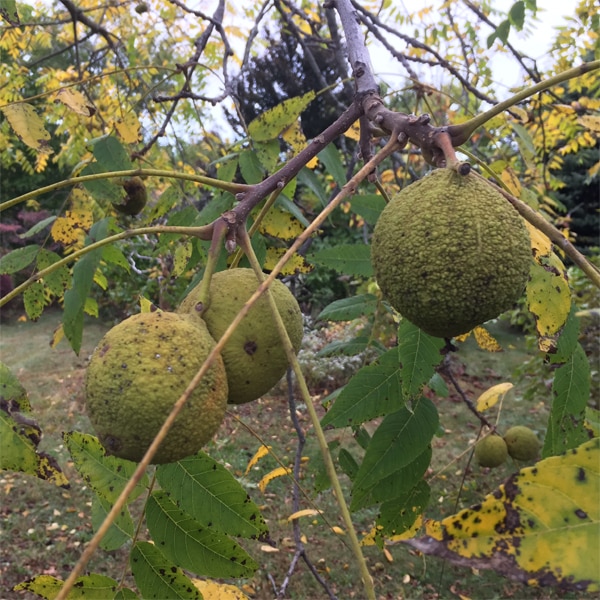
Each October black walnut’s distinctive fruit drops to the ground, ripe for harvest by me or the squirrels; even trees only ten years old can begin producing nuts. As the nuts drop, so do the leaves, perfuming the air and making the ground beneath rather untidy. Shelled black walnut “meats” have a distinctive, rich/oily, strong earthy flavor, far more intense than the familiar, milder-tasting English walnut we find in the grocery store. It’s a key traditional baklava ingredient. But the husks are messy to harvest and releasing the kernels from their thick shells is a challenge.
Each ripe nut is fully-clothed in a green, 2-3” thick, fragrant, fibrous husk; it’s prudent to remove the nut from the just-fallen husk rather than waiting until it decomposes to slimy black. Substances in the husk will seriously stain your hands, so be sure to wear rubber gloves when handling the hulls.
I stomp them with my boot (or drive my vehicle over an assembled group) to release the nut, and then tumble to clean with its sisters in a bucket of water. After a couple of rinses, spread out the corrugated nuts to dry for a few days (protected from squirrels) and they’ll be ready to plant-out or to season for eating later.
Let the nuts dry for a month or more before trying to crack them. To get at the kernel I use a hammer on a hard surface to just gently fracture the tough shell.
I then use a modified wire-cutter hand-tool with a small notch in the tip to nibble-away at the shell sections to release the kernel; be sure to protect your eyes from flying shell pieces! It’s unlikely that you’ll get a full kernel, but the smaller pieces are just as tasty. Be extra careful to remove every piece of shell: ground-up black walnut shells are used as an industrial abrasive and it’s disconcerting to bite into even a tiny piece!
Typically living for more than 100 years, a black walnut (Juglans nigra) tree matures in a few decades to as much as 100 ft. high in its native east-central USA. It’s not so common in New England, nor a popular nursery tree for homeowners, so most garden centers in this region do not stock it.
Its coarsely-branched limbs, two-foot-long compound foliage and deeply-furrowed grey bark all carry a distinctive, pungent aroma. It is commonly reputed to be an allelopathic tree, supposedly inhibiting the growth of nearby sensitive plants. But I’ve not seen this effect during all the decades I’ve grown it in my gardens.
Despite its various drawbacks, black walnut has been an intriguing tree for me to grow. Many decades ago I began working with walnut wood, appreciating its distinctive color and grain patterns. Back then I planted lots of seed and grew dozens of trees, fanaticizing about harvesting my own lumber in a few decades (never happened!).
I now often see volunteer black walnut seedlings in my gardens, forgotten by the squirrels who cached them for winter consumption. If one germinates too near another plant, remove it as soon as you see it. The deep taproot requires a spade to lift, but while it is dormant, it can be readily transplanted to a better location.
Wayne Mezitt is a 3rd generation nurseryman, a Massachusetts Certified Horticulturist, now chairman of Weston Nurseries of Hopkinton, Chelmsford & Hingham MA, and owner of “Hort-Sense”, a horticultural advisory business. He currently serves in various capacities on several horticulturally-related organizations, including the Massachusetts Horticultural Society at The Gardens at Elm Bank in Wellesley MA, and chairman for the Massachusetts Invasive Plant Advisory Group (MIPAG).







